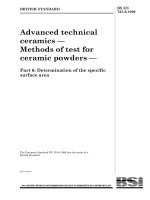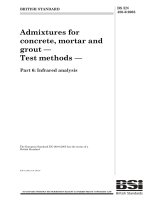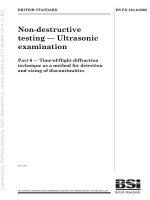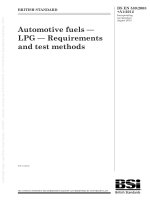Bsi bs en 62341 6 3 2012
Bạn đang xem bản rút gọn của tài liệu. Xem và tải ngay bản đầy đủ của tài liệu tại đây (1.73 MB, 36 trang )
BS EN 62341-6-3:2012
BSI Standards Publication
Organic light emitting
diode (OLED) displays
Part 6-3: Measuring methods of
image quality
NO COPYING WITHOUT BSI PERMISSION EXCEPT AS PERMITTED BY COPYRIGHT LAW
raising standards worldwide™
BRITISH STANDARD
BS EN 62341-6-3:2012
National foreword
This British Standard is the UK implementation of EN 62341-6-3:2012. It is
identical to IEC 62341-6-3:2012.
The UK participation in its preparation was entrusted to Technical Committee
EPL/47, Semiconductors.
A list of organizations represented on this committee can be obtained on
request to its secretary.
This publication does not purport to include all the necessary provisions of a
contract. Users are responsible for its correct application.
© The British Standards Institution 2012
Published by BSI Standards Limited 2012
ISBN 978 0 580 65574 6
ICS 31.260
Compliance with a British Standard cannot confer immunity from
legal obligations.
This British Standard was published under the authority of the Standards
Policy and Strategy Committee on 31 October 2012.
Amendments issued since publication
Amd. No.
Date
Text affected
BS EN 62341-6-3:2012
EUROPEAN STANDARD
EN 62341-6-3
NORME EUROPÉENNE
September 2012
EUROPÄISCHE NORM
ICS 31.260
English version
Organic light emitting diode (OLED) displays Part 6-3: Measuring methods of image quality
(IEC 62341-6-3:2012)
Afficheurs à diodes électroluminescentes
organiques (OLED) Partie 6-3: Méthodes de mesure de la
qualité des images
(CEI 62341-6-3:2012)
Anzeigen mit organischen Leuchtdioden
(OLEDs) Teil 6-3: Messverfahren für Bildqualität
(IEC 62341-6-3:2012)
This European Standard was approved by CENELEC on 2012-09-13. CENELEC members are bound to comply
with the CEN/CENELEC Internal Regulations which stipulate the conditions for giving this European Standard
the status of a national standard without any alteration.
Up-to-date lists and bibliographical references concerning such national standards may be obtained on
application to the CEN-CENELEC Management Centre or to any CENELEC member.
This European Standard exists in three official versions (English, French, German). A version in any other
language made by translation under the responsibility of a CENELEC member into its own language and notified
to the CEN-CENELEC Management Centre has the same status as the official versions.
CENELEC members are the national electrotechnical committees of Austria, Belgium, Bulgaria, Croatia, Cyprus,
the Czech Republic, Denmark, Estonia, Finland, Former Yugoslav Republic of Macedonia, France, Germany,
Greece, Hungary, Iceland, Ireland, Italy, Latvia, Lithuania, Luxembourg, Malta, the Netherlands, Norway, Poland,
Portugal, Romania, Slovakia, Slovenia, Spain, Sweden, Switzerland, Turkey and the United Kingdom.
CENELEC
European Committee for Electrotechnical Standardization
Comité Européen de Normalisation Electrotechnique
Europäisches Komitee für Elektrotechnische Normung
Management Centre: Avenue Marnix 17, B - 1000 Brussels
© 2012 CENELEC -
All rights of exploitation in any form and by any means reserved worldwide for CENELEC members.
Ref. No. EN 62341-6-3:2012 E
BS EN 62341-6-3:2012
EN 62341-6-3:2012
-2-
Foreword
The text of document 110/374/FDIS, future edition 1 of IEC 62341-6-3, prepared by IEC/TC 110, "Flat
panel display devices", was submitted to the IEC-CENELEC parallel vote and approved by CENELEC as
EN 62341-6-3:2012.
The following dates are fixed:
•
•
latest date by which the document has
to be implemented at national level by
publication of an identical national
standard or by endorsement
latest date by which the national
standards conflicting with the
document have to be withdrawn
(dop)
2013-06-13
(dow)
2015-09-13
Attention is drawn to the possibility that some of the elements of this document may be the subject of
patent rights. CENELEC [and/or CEN] shall not be held responsible for identifying any or all such patent
rights.
Endorsement notice
The text of the International Standard IEC 62341-6-3:2012 was approved by CENELEC as a European
Standard without any modification.
BS EN 62341-6-3:2012
EN 62341-6-3:2012
-3-
Annex ZA
(normative)
Normative references to international publications
with their corresponding European publications
The following documents, in whole or in part, are normatively referenced in this document and are
indispensable for its application. For dated references, only the edition cited applies. For undated
references, the latest edition of the referenced document (including any amendments) applies.
NOTE When an international publication has been modified by common modifications, indicated by (mod), the relevant EN/HD
applies.
Publication
Year
Title
EN/HD
Year
IEC 62341-1-2
2007
Organic light emitting diode displays Part 1-2: Terminology and letter symbols
EN 62341-1-2
2009
CIE 15
2004
Colorimetry
-
-
ISO 11664-1/
CIE S 014-1
-
Colorimetry Part 1: CIE standard colorimetric observers
-
-
ISO 11664-5
CIE S 014-5
-
Colorimetry Part 5: CIE 1976 L*u*v* Colour space and u',
v' uniform chromaticity scale diagram
-
–2–
BS EN 62341-6-3:2012
62341-6-3 © IEC:2012
CONTENTS
1
Scope ............................................................................................................................... 6
2
Normative references ....................................................................................................... 6
3
Terms, definitions, symbols, units and abbreviations ........................................................ 6
4
3.1 Terms, definitions, symbols and units ...................................................................... 6
3.2 Abbreviations .......................................................................................................... 6
Standard measuring equipment and coordinate system .................................................... 7
5
4.1 Light measuring devices .......................................................................................... 7
4.2 Viewing direction coordinate system ........................................................................ 7
Measuring conditions ........................................................................................................ 8
6
5.1 Standard measuring environmental conditions ......................................................... 8
5.2 Power supply ........................................................................................................... 9
5.3 Warm-up time .......................................................................................................... 9
5.4 Standard measuring dark-room conditions ............................................................... 9
5.5 Standard set-up conditions ...................................................................................... 9
Measuring methods of image quality ............................................................................... 10
6.1
6.2
6.3
6.4
6.5
Viewing angle range .............................................................................................. 10
6.1.1 Purpose ..................................................................................................... 10
6.1.2 Measuring conditions ................................................................................. 10
6.1.3 Set-up ....................................................................................................... 10
6.1.4 Measurement and evaluation ..................................................................... 11
6.1.5 Reporting................................................................................................... 12
Cross-talk .............................................................................................................. 13
6.2.1 Purpose ..................................................................................................... 13
6.2.2 Measuring conditions ................................................................................. 13
6.2.3 Measurement and evaluation ..................................................................... 13
6.2.4 Reporting................................................................................................... 16
Flicker ................................................................................................................... 16
6.3.1 Purpose ..................................................................................................... 16
6.3.2 Measuring conditions ................................................................................. 16
6.3.3 Set-up ....................................................................................................... 16
6.3.4 Measuring method ..................................................................................... 17
6.3.5 Evaluation method ..................................................................................... 17
6.3.6 Reporting................................................................................................... 19
Static image resolution .......................................................................................... 19
6.4.1 Purpose ..................................................................................................... 19
6.4.2 Measuring conditions ................................................................................. 20
6.4.3 Measuring method ..................................................................................... 20
6.4.4 Calculation and reporting ........................................................................... 20
Moving image resolution ........................................................................................ 21
6.5.1 Purpose ..................................................................................................... 21
6.5.2 Measuring conditions ................................................................................. 21
6.5.3 Temporal integration method ..................................................................... 23
6.5.4 Image tracking method .............................................................................. 25
6.5.5 Dynamic MTF calculation ........................................................................... 27
BS EN 62341-6-3:2012
62341-6-3 © IEC:2012
–3–
6.5.6 Reporting................................................................................................... 27
Annex A (informative) Simple matrix method for correction stray light of imaging
instruments ........................................................................................................................... 28
Bibliography .......................................................................................................................... 30
Figure 1 – Representation of the viewing direction (equivalent to the direction of
measurement) by the angle of inclination, θ and the angle of rotation (azimuth angle),
φ in a polar coordinate system ................................................................................................ 8
Figure 2 – DUT installation conditions ..................................................................................... 9
Figure 3 – Geometry used for measuring viewing angle range .............................................. 11
Figure 4 – Standard measurement positions, indicated by P 0 -P 8 , are located relative
to the height (V) and display width (H) of active area. ........................................................... 13
Figure 5 – Luminance measurement of 4 % window at P 0 ..................................................... 14
Figure 6 – Luminance measurement at P 0 with windows A W1 ,AW2 , A B3 and A B4 ................... 15
Figure 7 – Luminance measurement at P 0 with windows A W5 , AW8 , A B5 and A B8 .................. 15
Figure 8 – Apparatus arrangement ........................................................................................ 16
Figure 9 – Temporal contrast sensitivity function .................................................................. 18
Figure 10 – Example of flicker modulation waveform ............................................................. 18
Figure 11 – Contrast modulation measurement ..................................................................... 21
Figure 12 – Peak luminance and amplitude of display test signal .......................................... 23
Figure 13 – Set-up for measurement of the temporal response of the DUT ........................... 23
Figure 14 – Sinusoidal luminance pattern and corresponding gray level values .................... 24
Figure 15 – Input code sequences (left) and corresponding temporal luminance
transitions (right)................................................................................................................... 25
Figure 16 – Example of captured image ................................................................................ 26
Figure 17 – Example of Fourier transform ............................................................................. 27
Figure 18 – Example of limit resolution evaluation ................................................................ 27
Figure A.1 – Result of spatial stray light correction for an imaging photometer used to
measure a black spot surrounded by a large bright light source. ........................................... 29
Table 1 – Temporal contrast sensitivity function .................................................................... 17
–6–
BS EN 62341-6-3:2012
62341-6-3 © IEC:2012
ORGANIC LIGHT EMITTING DIODE (OLED) DISPLAYS –
Part 6-3: Measuring methods of image quality
1
Scope
This part of IEC 62341 specifies the standard measurement conditions and measuring
methods for determining image quality of organic light emitting diode (OLED) display panels
and modules. More specifically, this standard focuses on five specific aspects of image quality,
i.e., the viewing angle range, cross-talk, flicker, static image resolution, and moving image
resolution.
2
Normative references
The following documents, in whole or in part, are normatively referenced in this document and
are indispensable for its application. For dated references, only the edition cited applies. For
undated references, the latest edition of the referenced document (including any
amendments) applies.
IEC 62341-1-2:2007, Organic light emitting diode (OLED) displays – Part 1-2: Terminology
and letter symbols
CIE 015:2004, Colorimetry, 3rd Edition
ISO 11664-1/CIE S 014-1, Colorimetry – Part 1: CIE standard colorimetric observers
ISO 11664-5/CIE S 014-5, Colorimetry – Part 5: CIE 1976 L*u*v* Colour space and u', v'
uniform chromaticity scale diagram
3
Terms, definitions, symbols, units and abbreviations
3.1
Terms, definitions, symbols and units
For the purposes of this document, the terms, definitions, symbols and units given in
IEC 62341-1-2 apply.
3.2
Abbreviations
CCD
Charge coupled device
CIE
International Commission on Illumination
(Commission Internationale de L’Éclairage)
CFF
Critrical flicker frequency
CIELAB
CIE 1976 (L*a*b*) colour space
DUT
Device under test
HVS
Human visual system
LED
Light emitting diode
LMD
Light measuring device
OLED
Organic light emitting diode
ppf
pixels per frame
BS EN 62341-6-3:2012
62341-6-3 © IEC:2012
PSF
Point spread function
RGB
Red, green, blue
SLSF
Spectral line spread function
4
4.1
–7–
Standard measuring equipment and coordinate system
Light measuring devices
The system configurations and/or operating conditions of the measuring equipment shall
comply with the structure specified in each item.
To ensure reliable measurements, the following requirements apply to the light measuring
equipment, listed below:
a) Luminance meter [1] 1 : the instrument's spectral responsivity shall comply with the CIE
’
photopic luminous efficiency function with a CIE-f 1 value no greater than 3 % [2]; the
relative luminance uncertainty of measured luminance (relative to CIE illuminant A source)
shall not be greater than 4 % for luminance values over 10 cd/m 2 and not be greater than
10 % for luminance values 10 cd/m 2 and below.
b) Colorimeter: the detector’s spectral responsivity shall comply with the colour matching
functions for the CIE 1931 standard colorimetric observer (as defined in
ISO 11664-1/CIE S 014-1) with a colorimetric accuracy of 0,002 for the CIE chromaticity
coordinates x and y (relative to CIE illuminant A source). A correction factor can be used
for required accuracy by application of a standard source with similar spectral distribution
as the display to be measured.
c) Spectroradiometer: the wavelength range shall be at least from 380 nm to 780 nm, and
the wavelength scale accuracy shall be less than 0,5 nm. The relative luminance
uncertainty of measured luminance (relative to CIE illuminant A source) shall not be
greater than 4 % for luminance values over 10 cd/m 2 and not be greater than 10 % for
luminance values 10 cd/m 2 and below. Note that errors from spectral stray light within a
spectroradiometer can be significant and shall be corrected. A simple matrix method may
be used to correct the stray light errors, by which stray light errors can be reduced for one
to two orders of magnitudes. Details of this correction method are discussed in [3].
d) Goniophotometric mechanism: the DUT or LMD can be driven rotating around a horizontal
axis and vertical axis; angle accuracy shall be better than 0,5°.
e) Imaging colorimeter: number of pixels of the detector shall not be less than 4 for each
display sub-pixel within the colorimeter's measurement field of view; more than 12 bit
digital resolution; spectral responsivity complies with colour matching functions for the
CIE 1931 standard colorimetric observer with colorimetric accuracy of 0,004 for the CIE
’
coordinates x and y, and photopic vision response function with CIE-f 1 no greater than
3 %.
f)
4.2
Fast-response photometer: the linearity shall be better than 0,5 % and frequency
’
response higher than 1 kHz; and photopic vision response function with CIE-f 1 no greater
than 5 %.
Viewing direction coordinate system
The viewing direction is the direction under which the observer looks at the spot of interest on
the DUT (see also IEC 62341-1-2:2007, Figure A.2). During the measurement, the LMD is
replacing the observer, looking from the same direction at a specified spot (i.e. measuring
spot, measurement field) on the DUT. The viewing direction is conveniently defined by two
angles: the angle of inclination θ (related to the surface normal of the DUT) and the angle of
rotation φ (also called azimuth angle) as illustrated in Figure 1. The azimuth angle is related to
—————————
1
Numbers in square brackets refer to the bibliography.
BS EN 62341-6-3:2012
62341-6-3 © IEC:2012
–8–
the directions on a watch-dial as follows: φ = 0° is referred to as the 3 o'clock direction
("right"), φ = 90 ° as the 12 o'clock direction ("top"), φ = 180° as the 9 o'clock direction ("left")
and φ = 270 ° as the 6 o'clock direction ("bottom").
Normal direction
θ = 0°
Viewing direction
(θ , φ)
z
θ
12 o’clock
φ = 90°
Upside
9 o’clock
φ = 180°
y
φ
x′
x
3 o’clock
φ = 0°
Display plane
6 o’clock
φ = 270°
y′
Down side
z′
IEC 1573/12
Key
θ
incline angle from normal direction
φ
azimuth angle
3 o’clock
right edge of the screen as seen from the user
6 o’clock
bottom edge of the screen as seen from the user
9 o’clock
left edge of the screen as seen from the user
12 o’clock
top edge of the screen as seen from the user
Figure 1 – Representation of the viewing direction (equivalent to the direction of
measurement) by the angle of inclination, θ , and the angle of rotation (azimuth angle),
φ in a polar coordinate system
5
Measuring conditions
5.1
Standard measuring environmental conditions
Measurements shall be carried out under the standard environmental conditions:
•
temperature:
25 ºC ± 3 ºC;
•
relative humidity:
25 % RH to 85 % RH;
•
atmospheric pressure: 86 kPa to 106 kPa.
When different environmental conditions are used, they shall be noted in the measurement
report.
BS EN 62341-6-3:2012
62341-6-3 © IEC:2012
5.2
–9–
Power supply
The power supply for driving the DUT shall be adjusted to the rated voltage ± 0,5 %. In
addition, the frequency of power supply shall provide the rated frequency ± 0,2 %.
5.3
Warm-up time
Measurements shall be carried out after sufficient warm-up. Warm-up time is defined as the
time elapsed from when the supply source is switched on, and a 100 % gray level of input
signal is applied to the DUT, until repeated measurements of the display show a variation in
luminance of no more than 2 % per minute and 5 % per hour.
5.4
Standard measuring dark-room conditions
The luminance contribution from the background illumination reflected off the test display
shall be < 0,01 cd/m 2 or less than 1/20 the display’s black state luminance, whichever is lower.
If these conditions are not satisfied, then background subtraction is required and it shall be
noted in the measurement report. In addition, if the sensitivity of the LMD is inadequate to
measure these low levels, then the lower limit of the LMD shall be noted in the measurement
report.
5.5
Standard set-up conditions
By default, the display shall be installed in the vertical position (Figure 2a), but the horizontal
alternative (Figure 2b) is also allowed. When the latter alternative is used, it shall be noted in
the measurement report.
Luminance, contrast and chromaticity of the white field and other relevant parameters of the
displays have to be adjusted to nominal status in the detailed specification and they shall be
noted in the measurement report. When there is no level specified, the maximum contrast
and/or luminance level shall be used. These adjustments shall be held constant for all
measurements, unless noted otherwise in the measurement report. Additional conditions are
specified separately for each measuring method.
12 o’clock
φ = 90°
y
Vertical
θ = 0°
Vertical
(normal)
9 o’clock
φ = 180°
Horizontal
x
Normal
z
LMD
θ = 0°
6 o’clock
φ = 270°
IEC 1574/12
Figure 2a – Primary installation
LMD
z
12 o’clock
φ = 90°
y
Horizontal
9 o’clock
φ = 180°
3 o’clock
φ = 0°
x
3 o’clock
φ = 0°
6 o’clock
φ = 270°
IEC 1575/12
Figure 2b – Alternative installation
Figure 2 – DUT installation conditions
– 10 –
6
BS EN 62341-6-3:2012
62341-6-3 © IEC:2012
Measuring methods of image quality
6.1
6.1.1
Viewing angle range
Purpose
The purpose of this method is to measure the viewing angle range of an OLED display module
in the horizontal ( φ = 0˚, φ = 180˚) and vertical ( φ = 90˚, φ = 270˚) viewing direction. Different
evaluation criteria are described with which the viewing angle range can be determined.
Several studies [4 – 8] have indicated that the contrast ratio (CR > 10:1) is, from a visual
quality point of view, not very useful to determine the viewing angle range for matrix displays.
When colour differences are included in a viewing angle metric, the correlation between the
metric value and a visual assessment value is significantly increased [9]. A more recent study
[10] revealed that a metric, combining viewing angle related luminance degradation and colour
deviation can accurately predict the relative change in visual assessment value. This
information is the basis for the determination of the image quality based viewing angle range,
which has relevance from a visual quality point of view.
6.1.2
Measuring conditions
Standard measuring is implemented under standard dark-room and set-up conditions.
6.1.3
Set-up
a) Apparatus: an LMD to measure luminance and chromaticity of the DUT; driving power
source; driving signal equipment; geometric mechanism illustrated in Figure 3.
b) Mount the display and LMD in a mechanical system that allows the display to be
measured along its vertical and horizontal plane, which lie normal to the display surface.
Figure 3 illustrates the geometry to be used in this measurement. The angle relative to the
display normal in the horizontal plane, 3 o’clock and 9 o’clock direction, is expressed as
θ H , and the angle in the vertical plane, 6 o’clock and 12 o’clock direction, by θ V . Either the
display can be tilted to scan both planes, or the LMD can be moved within these planes.
During the measuring procedure, the LMD shall be directed at the same field of
measurement for all angles of inclination. In either case, the centre of the measurement
field shall remain at the same location on the DUT surface for all angles of inclination. The
angular positioning of the display in the goniophotometric system shall be accurate to ±
0,5°, and the measuring range shall be implemented from -90° to +90° both in vertical and
horizontal plane.
BS EN 62341-6-3:2012
62341-6-3 © IEC:2012
Vertical
– 11 –
y
θV
Viewing
direction
θV
Horizontal
Normal
θH
x
z
LMD
θH
IEC 1576/12
IEC 1577/12
Figure 3a – Geometric structure
of display to be measured
Figure 3b – Geometric system
Figure 3 – Geometry used for measuring viewing angle range
c) Input signal to the DUT:
1)
To determine the luminance (L) and CIE 1976 (as defined in ISO 11664-5/CIE S 014-5)
chromaticity coordinates (u’, v’) related viewing angle ranges, generate a full white
screen with a 100 % signal level (R = G = B = 255 for an 8 bit input signal) on the
display.
2)
To determine the contrast ratio (CR) related viewing angle range, generate a full white
screen with a 100 % signal level (R = G = B = 255 for an 8 bit input signal) on the
display to measure the maximum display luminance (L max) and subsequently a full
black screen with 0 % signal level (R = G = B = 0 for an 8 bit input signal) to measure
the minimum luminance (L min ). The contrast ratio is defined by:
CR =
Lmax
Lmin
(1)
3) To determine the image quality related viewing angle range, generate a full screen
grey pattern with a 78,,4 % signal level (R=G=B=200 for an 8 bit input signal) on the
display to measure the luminance (L) and the CIE 1976 chromaticity coordinates (u’,
v’) [11].
d) Align the LMD perpendicular to the display surface ( θ = 0, φ = 0), and position it to the
centre of the display (position P 0 in Figure 4).
6.1.4
Measurement and evaluation
Proceed as follows:
a) Apply the required input signal(s) to the DUT.
b) Measure the centre luminance (L 0 ), chromaticity coordinates (u’0 , v’0 ) and contrast ratio
(CR 0 ) perpendicular to the display surface ( θ = 0°, φ = 0°). The measurement area shall
cover at least 500 pixels, or demonstrate equivalent results with fewer sampled pixels.
c) Take luminance (L θ , φ), chromaticity coordinates (u’θ , φ, v’θ , φ) and contrast ratio (CR θ , φ)
measurements as the LMD steps through the various angles in the horizontal ( φ = 0°,
φ = 180°) and vertical ( φ = 90°, φ = 270°) viewing planes.
– 12 –
BS EN 62341-6-3:2012
62341-6-3 © IEC:2012
d) Record the change in luminance and chromaticity coordinates from the perpendicular
direction.
1) The luminance change is defined in terms of the luminance ratio:
LRθ ,φ =
Lθ ,φ
L0
(2)
2) Colour shifts with viewing angle are to be determined relative to chromaticity
coordinates measured at the display normal. The change in colour is defined by the
colour difference equation using the CIE 1976 uniform colour space:
∆u ' v 'θ ,φ = (u ' 0 −u 'θ ,φ ) 2 + (v ' 0 −v 'θ ,φ ) 2
(3)
e) Determine in each of the four viewing directions ( φ = 0°, φ = 180°, φ = 90°, φ = 270°), the
angles ( θφ = 0°, θφ = 180°, θφ = 90°, θφ = 270°) at which the specified conditions are met:
1) For the luminance based viewing angle range, when the luminance ratio (LR),
calculated with Equation (2), equals 50 % or any other agreed upon value, specified in
the detail specification.
2) For the contrast ratio based viewing angle range, when the contrast ratio (CR θ , φ),
calculated with Equation (1), equals 100 or any other agreed upon value, specified in
the detail specification.
3) For the colour based viewing angle range, when the colour difference (∆u’v’),
calculated with Equation (3), equals 0,01 or any other agreed upon value, specified in
the detail specification.
4) For the image quality based viewing angle range, in which both the change in
luminance and the change in colour are considered, the condition specified in
Equation (4) applies:
IQ = LRθ ,φ − 28 × ∆u ' v ' ≥ 0,36
(4)
where
LRθ ,φ =
Lθ ,φ
L0
and
∆u ' v ' = (u '0 −u 'θ ,φ ) 2 + (v '0 −v 'θ ,φ ) 2
NOTE Other measurement systems, such as conoscopic instruments, can also be used for the viewing angle
range measurement, if equivalent results can be demonstrated.
6.1.5
Reporting
The horizontal and vertical viewing angles ranges shall be calculated according to Equation (5)
on horizontal viewing angle range and Equation (6) on vertical viewing angle range.
θ VAR,H = θ φ = 0° + θ φ = 180°
(5)
θ VAR,V = θ φ = 90° + θ φ = 270°
(6)
The horizontal and vertical viewing angle ranges shall be noted in the measurement report,
together with the used criteria, e.g. LR ≥ 0,50, CR > 100, ∆u’v’ ≤ 0,01, or image quality based.
BS EN 62341-6-3:2012
62341-6-3 © IEC:2012
6.2
– 13 –
Cross-talk
6.2.1
Purpose
The purpose of this method is to measure the cross coupling of electrical signals between
elements (cross-talk) of an OLED display module.
6.2.2
Measuring conditions
The following measuring conditions apply:
a) Apparatus: an LMD that can measure luminance, a driving power source, and driving
signal equipment.
b) Standard measuring environmental conditions; dark-room condition; standard set-up
conditions.
c) The LMD shall be aligned perpendicularly to position P 0 in Figure 4 to measure the
luminance.
H/2
H/10
P5
P2
P8
P0
P6
P4
P7
P3
V/10
V
V/2
P1
H
IEC 1578/12
Figure 4 – Standard measurement positions, indicated by P 0 - P 8 , located
relative to the height (V) and display width (H) of active area
6.2.3
Measurement and evaluation
Proceed as follows:
a) Measure the maximum white level window luminance, L w,max, at the centre of the active
area (position P 0 in Figure 4).
Input signal is a 4 % white window pattern, with 100 % signal level, on a black background,
0 % signal level, in the centre of the active area, as shown in Figure 5. The 4 % window
has corresponding sides that are 1/5 the vertical and horizontal dimensions of the active
area. For a monochrome display, apply a signal at the highest grey level. For a colour
display, apply a white signal level of 100 %.
– 14 –
BS EN 62341-6-3:2012
62341-6-3 © IEC:2012
IEC 1579/12
Figure 5 – Luminance measurement of 4 % window at P 0
b) Set the input signal to an 18 % grey level (R = G = B = 46), to measure the window
luminance, L w,18 %, at the centre of the active area (position P 0 in Figure 4).
Input signal is a 4 % white window pattern, with 18 % signal level, on a black background,
0 % signal level, in the centre of the active area, as shown in Figure 5. The 4 % window
has corresponding sides that are 1/5 the vertical and horizontal dimensions of the active
area.
For a colour display, apply a white signal level of 100 %.
c) Measure the 18 % level window luminance, L w,18 %, at the centre of the active area
(position P 0 in Figure 4).
Input signal is a 4 % white window pattern, with 18 % signal level, on a black background,
0 % signal level, in the centre of the active area, as shown in Figure 5. The 4 % window
has corresponding sides that are 1/5 the vertical and horizontal dimensions of the active
area.
d) Measure the 18 % level full-screen luminance, L FS,18 % , at the centre of the active area
(position P 0 in Figure 4).
Input signal is a full screen grey pattern, with 18 % signal level.
e) Measure the 18 % luminance signal LW _ OFF and L B _ OFF at the centre of the active area
(position P 0 in Figure 4).
In total, there are eight input patterns used in this step, which are indicated in Figure 6.
Figure 6 (left pattern) indicates the input signal pattern with the positions of the white
segments A wi,(i=1-4) which shall successively be activated to measure the luminance
L wi,(i=1-4) at P 0 . The signal level of the white blocks is 100 % white, while background
luminance level is 18 % white.
Figure 6 (right pattern) indicates the input signal pattern with the positions of the black
segments A Bi,(i=1-4) which shall successively be activated to measure the luminance
L Bi,(i=1-4) at P 0 . The signal level of the black blocks is 0 % white, while background
luminance level is 18 % white.
LW_OFF and L B_OFF are computed as follows.
L w_OFF =
L w1 + L w2 + L w3 + L w4
4
(7)
LB_OFF =
LB1 + LB2 + LB3 + LB4
4
(8)
BS EN 62341-6-3:2012
62341-6-3 © IEC:2012
– 15 –
IEC 1580/12
Figure 6 – Luminance measurement at P 0 with windows AW1 , AW2 , AB3 and AB4
f)
Measure the 18 % luminance signal, L Wi_ON and L Bi_ON , at the centre of the active area
(position P 0 in Figure 4).
There are also two input patterns with 8 measuring points used in this step, which are
indicated in Figure 7.
Figure 7 (left pattern) indicates the input signal pattern with the positions of the white
segments A wi,(i=5-8) which shall successively be activated to measure the luminance
L wi_ON,(i=5-8) at P 0 . The signal level of the white blocks is 100 % white, while background
luminance level is 18 % white.
Figure 7 (right pattern) indicates the input signal pattern with the positions of the black
segments A Bi,(i=5-8) which shall successively be activated to measure the luminance
L Bi_ON,(i=5-8) at P 0 . The signal level of the black blocks is 0 % white, while background
luminance level is 18 % white.
IEC 1581/12
Figure 7 – Luminance measurement at P 0 with windows AW5 , AW8 , AB5 and AB8
g) Calculating cross-talk
CT =
LWi_ON − LW_OFF
4
× 100 %(i = 5 to 8)
(9)
× 100 % (i = 5 to 8)
(10)
for white windows A Wi (i = 5 to 8), and
CT =
LBi_ON − LB_OFF
LB_OFF
for black windows A Bi (i = 5 to 8).
The maximum cross-talk value shall be noted in the measurement report.
– 16 –
6.2.4
BS EN 62341-6-3:2012
62341-6-3 © IEC:2012
Reporting
The following information shall be noted in the measurement report:
a)
the maximum cross-talk in per cent with 100 % white window and black window;
b)
the position of window that affect the maximum cross-talk at P 0 ;
luminance at P 0 with following conditions
c)
–
LW,max,
–
LW,18 %,
–
L FS,18 %,
–
LW_OFF and L Wi_ON in case of the maximum cross-talk with white window,
–
L B_OFF and L Bi_ON in case of the maximum cross-talk with black window.
6.3
Flicker
6.3.1
Purpose
The purpose of this method is to measure the potential of an observable flicker from an OLED
display module.
6.3.2
Measuring conditions
The following measuring conditions apply:
a)
b)
apparatus: a signal generator , a frequency analyser, and an LMD with the following
characteristics to record the luminance as a function of time
1)
CIE photopic vision spectral response,
2)
capable of producing a linear response to rapid changes in luminance,
3)
frequency response: greater than 1 kHz,
4)
field angle of view: less than 5°,
5)
the LMD shall be dark field (zero) corrected;
standard measuring environmental conditions; dark-room illumination; standard set-up
conditions.
6.3.3
6.3.3.1
Set-up
Geometric arrangement
DUT
LMD
Frequency analyser
Signal generator
IEC 1582/12
Figure 8 – Apparatus arrangement
BS EN 62341-6-3:2012
62341-6-3 © IEC:2012
– 17 –
a)
Optical axis of the LMD is in accordance with central normal line of the DUT (see
Figure 8).
b)
Measurement region: larger than 500 pixels.
c)
Measuring distance: twice the diagonal distance of DUT. The minimum distance shall be
500 mm.
6.3.3.2
Pattern
The nominal test pattern is constant full screen white at specified level (LW ), which shall be
noted in the measurement report. If other empirically or analytically derived worst-case test
patterns are used, the changed colour, drive level, pattern, and/or viewing direction shall be
noted in the measurement report.
6.3.4
Measuring method
Proceed as follows:
a)
Set the DUT under the standard measuring conditions.
b)
Display the selected test pattern, and wait until the test pattern is stable.
c)
Measure the luminance as a function of time L( t ) with the LMD.
6.3.5
6.3.5.1
Evaluation method
Flicker modulation amplitude
a)
Analyse the luminance and perform a Fourier transform with the array of data L( t ), to
acquire the power spectrum P(F).
b)
Weight the power spectrum P(F) with temporal contrast sensitivity function, see Figure 9,
to obtain perceptive power spectrum P’(F).
c)
Transform the P’(F) to the luminance as a function of time L’( t ) with the inverse Fourier
transform
Table 1 – Temporal contrast sensitivity function
Frequency
Hz
CR
CS
Frequency
Hz
%
CR
CS
%
1, 6
17 , 8
19 , 8
78 , 8
2, 7
17 , 9
24
59 , 8
4
32 , 9
28
29 , 9
5, 1
45 , 3
32
23
6, 8
50 , 3
40
5 , 89
8, 8
72 , 5
54
1 , 23
10, 7
96 , 7
64
0 , 79
12, 7
101 , 5
75
0 , 60
16, 2
91 , 3
BS EN 62341-6-3:2012
62341-6-3 © IEC:2012
– 18 –
2,00
1,00
Contrast sensitivity
0,50
0,20
0,10
0,05
0,02
0,01
2
5
10
20
50
Temporal frequency (Hz)
IEC 1583/12
Figure 9 – Temporal contrast sensitivity function
Subsequently, calculate the flicker modulation amplitude (A FM) as follows:
c)
obtain the average luminance, L' ave , the maximum luminance L' max , and the minimum
luminance L' min of L'(t), see Figure 10.
Calculate A FM via:
L'
−L' min
AFM = max
L' ave
× 100 %
(11)
L′max
L′min
L′ave
b)
determine the main flicker frequency f m from the maximum of P'(f);
determine the flicker modulation amplitude A FM in per cent from L'(t) as follows:
Luminance L′ (t)
a)
IEC 1584/12
Figure 10 – Example of flicker modulation waveform
BS EN 62341-6-3:2012
62341-6-3 © IEC:2012
6.3.5.2
– 19 –
Critical flicker frequency (CFF)
From the acquired temporal luminance data (L(t)) in order like to predict if flicker will be
observed, the model already described by Farrell [12] can be successfully used (see [13].
The calculated critical flicker frequency (CFF) value represents the lowest refresh rate to
render a display flicker-free. If the refresh rate of a display is higher than the CFF, it is
predicted that the observer will not perceive flicker. If the refresh rate is lower than the CFF,
visible flicker is predicted.
CFF = m + n {ln[E ret × M (f )]}
Eret = Lav × Apupil
2
Apupil = π × (d / 2)
d = 5 − 3 × tanh[0,4 × log(L × 3,183)]
av
(Hz )
(12)
(td )
(mm2 )
(mm)
(13)
where
m = -ln(a/b)
n = 1/b
and where E ret is the retinal illumination, which depends on the average display luminance
entering the eye (L av ) and the pupil area (A pupil ), which, in turn, depends on the pupil
diameter d), M(f) represents the normalized modulation amplitude of the fundamental
frequency, derived from the recorded time varying screen luminance (L(t)), and a and b are
constants, only depending on the display size (for the applicable values, see [12].
6.3.6
Reporting
In the case that the flicker modulation amplitude has been calculated, according to 6.3.5.1,
the following information shall be noted in the measurement report:
•
the test pattern that was used to produce the luminance variations;
•
temporal CSF that was used for filtering the recorded luminance;
•
the minimum luminance (L’min ), maximum luminance (L’max ) and the average luminance
(L’av ) of the filtered temporal luminance (L’(t)), see Figure 11).
•
the flicker modulation amplitude (A FM), and its main modulation frequency f M.
Where the critical flicker frequency has been calculated, according to 6.3.5.2, the following
information shall be noted in the measurement report:
•
the test pattern that was used to produce the luminance variations;
•
the values for parameters m and n, used in Equation (12);
•
the average display luminance (L av );
•
the calculated CFF value (in Hz), as well as the fundamental frequency (f) of the
modulation amplitude M(f).
6.4
6.4.1
Static image resolution
Purpose
The purpose of this method is to measure the static image resolution of an OLED display
module.
– 20 –
6.4.2
BS EN 62341-6-3:2012
62341-6-3 © IEC:2012
Measuring conditions
The following measuring conditions apply:
a)
apparatus: an LMD device; driving power source; driving signal equipment;
b)
the integrated time of measurement circuit shall be long enough so that the standard
deviation of measured luminance is no greater than 2 % of the average value. For LMDs
like CCD spectroradiometers or imaging photometers, the exposure time shall be a
multiple (n > = 1) of the frame time, such as CCD spectroradiometer or imaging
photometer;
c)
for an array detector, the number of pixels of the detector shall not be less than 4 for
each display subpixel within the measurement field of view. For a spot meter, the
diameter of the measurement spot shall be less than 1/3 of the pixel area;
d)
standard measuring environmental conditions; dark-room illumination; standard set-up
conditions; measurement perpendicular to display surface and in display centre;
e)
test patterns: horizontal or vertical lines with n white or black pixels, where n = 1 to 5.
6.4.3
Measuring method
Perform measurements of line profile and contrast for each pattern, for both the white and
black lines. Perform measurement for at least three lines both for black and white, and then
calculate the average of them.
With an array or scanning spot LMD, obtain the luminance profile of the vertical line as a
function of position. The direction of array or scanning LMD is perpendicular to the vertical
line.
Repeat for the horizontal line.
Stray light within an instrument, often called veiling glare, can cause serious measurement
errors. Thus, it is critical to apply a correction for instrument's stray light in order to obtain
measurement results such as contrast modulations with acceptable uncertainties. For an
array LMD, a simple matrix method for stray light correction may be used, by which stray light
errors can be reduced for one order of magnitude, see [3]. Annex A provides a brief
description of the matrix method. For a spot LMD, a replica mask or line mask may be used.
Details of the replica method are discussed in [14].
6.4.4
Calculation and reporting
Proceed as follows:
a) Calculate the contrast modulation for each pattern
Cm (n ) =
L w (n ) − Lk (n )
(n =1 to 5)
L w (n ) + Lk (n )
(14)
where L w(n) and L k (n) are the average luminance of all centre of white and black lines,
respectively.
b) Calculate the grille line width nr (in pixels)
The calculated grille line width is estimated by linear interpolation to be equal to the
contrast modulation threshold C T.
nr = n +
C T – Cm (n )
for Cm (n ) < C T < Cm (n + 1)
Cm (n + 1) – Cm (n )
(15)
The contrast modulation threshold C T , which is 50 % for text resolution and 25 % for
image resolution, depends on display application. An example for n r calculation is
BS EN 62341-6-3:2012
62341-6-3 © IEC:2012
– 21 –
provided in Figure 11, where pixel 0 is switched on and the measured contrast modulation
varies with the distance (in pixel) from the pixel 0.
100
Contrast modulation Cm (%)
90
80
70
60
50
= 1,156 8
n
40
30
20
10
0
4
2
3
Grille line width (pixels)
1
0
IEC 1585/12
Figure 11 – Contrast modulation measurement
c) Calculate the resolution (in number of resolvable lines/pixels) for both horizontal (pixels)
and vertical (lines) directions as follows:
SR (static resolution) =
Number of addressable lines
nr
(16)
d) The number of addressable lines/pixels, contrast modulation threshold (C T ), calculated
static resolution, and contrast modulation plots in both horizontal and vertical directions
shall be noted in the measurement report.
6.5
Moving image resolution
6.5.1
Purpose
Moving image rendering performance of an OLED display module relates to both the light
characteristics of the module and HVS. When viewing a moving image, it is assumed that the
human visual perception has the following properties: 1) smooth pursuit eye tracking of the
object; 2) temporal integration of luminance within one frame period. Based on these
assumptions, two different approaches are employed to characterize artifacts associated with
moving patterns which will closely mimic how the eye perceives them: 1) temporal integration
method according to the temporal luminance response measured by fixed optical detectors,
and 2) image tracking method. The purpose of these methods is to characterize the spatial
resolution as a function of motion speed [15 – 18].
6.5.2
6.5.2.1
Measuring conditions
Measuring equipment
The following equipment shall be used:
a) driving power source;
b) pattern generator which generates the test pattern that moves across the screen in the
specified directions with specified speeds. For the temporal integration method, a special
sequence of full-screen still images is required;
BS EN 62341-6-3:2012
62341-6-3 © IEC:2012
– 22 –
c) image tracking detecting system, or/and system to measure the temporal luminance
response as shown in Figures 8 and 13;
d) a computer for data acquisition and calculation.
6.5.2.2
Standard environmental conditions
a) standard dark-room condition;
b) standard environmental conditions.
6.5.2.3
Test patterns
The test patterns for the image tracking method shall be as follows:
a) sine wave row or column patterns, sinusoidal in the luminance domain, with specified
spatial frequency f s , or other specified patterns;
b) the amplitude and background level of the patterns can be controlled as measurement
parameters.
6.5.2.4
Parameters for test patterns
Motion speed and related parameters for the test images and for the analysis shall be
selected from the following list:
a) directions: left to right (horizontal), and top to bottom (vertical);
b) speed: equivalent to 1/15 screen/s, 1/10 screen/s, 1/5 screen/s, and 1/3 screen/s.
The unit for speed expressed here is the inverse of time (T, in seconds) in which the
image traverses the active screen area. For example, 1/15 screen/s means one screen
per 15 seconds. In practice, conventional pattern generators realize an image
displacement in an integer number of pixels per frame (ppf). The conversion from
screen/s to ppf is given by the following equation:
Speed =
Np
T ×f
( ppf )
(17)
where N p is the number of horizontally addressable pixels of the OLED display module, T
is the time (in seconds) the image moves across the screen, and f is the refresh rate of
the OLED display module in Hz.
c)
Spatial frequency, f s , of the displayed signal shall be selected from the following values:
100, 150, 200, 250, 300, 350, 400, 450, 500, 550, 600, 650, 700, 750, 800, 850, 900, 950,
and 960 (cycles/screen).
Not all of these values are required, but the proper values shall be selected to obtain the
valid limit resolution by interpolation and also to avoid spurious resolution. In order to
avoid moiré patterns and scaling artifacts, the OLED display module shall be driven in its
native resolution, and the spatial frequency shall be converted from cycles/screen to an
integer number of display pixels per cycle.
d)
Amplitude and background level of the test signal (see Figure 13) shall be selected from
following parameters:
Peak luminance level L p : 100 %, 75 %, and 50 % of the maximum display luminance
(L max).
Amplitude: 1/1 L p , 1/2 L p , and 1/4 L p.
BS EN 62341-6-3:2012
62341-6-3 © IEC:2012
– 23 –
Lp
Lp
Lp
1/4 Lp
Lp
1/2 Lp
12 a)
12 c)
12 b)
IEC 1586/12
NOTE
Amplitude is set to a) 1/1 L p , b) 1/2 L p , and c) 1/4 L p .
Figure 12 – Peak luminance and amplitude of display test signal
6.5.3
6.5.3.1
Temporal integration method
Principle of temporal light integration
DUT
LMD
Fast response
luminance detector
Signal generator
Data acquisition
Computer
IEC 1587/12
Figure 13 – Set-up for measurement of the temporal response of the DUT
A schematic representation of the measurement set-up to measure the temporal impulse
response is shown in Figure 13. When the image is moving (scrolling) across the display, the
eye is smoothly tracking the moving image and consequently, at the retina, the light is
integrated along the motion trajectory. Since the artifact mechanism is straightforward, an
accurate algorithm for the simulation of the perceived images is possible. When an image
moves on the screen with a speed of v pixels per frame, the perceived retinal image can be
calculated by the integration of the temporal luminance, taking into consideration the shift in
position, each frame period, as the eye follows the moving image. The perceived image is
expressed by Equation (18).
L' (x ') =
1
Tf
v −1
∑∫
i =0
i +1− x '
Tf
V
i −x '
Tf
V
Liv (t )dt
where
x’
is the position on the observation axis which is a retinal-projective coordinate;
(18)









